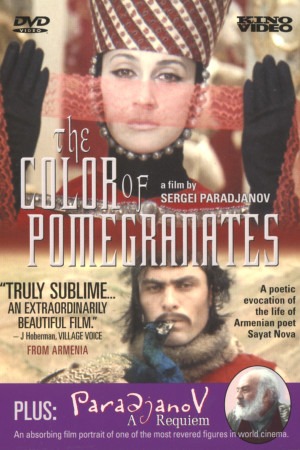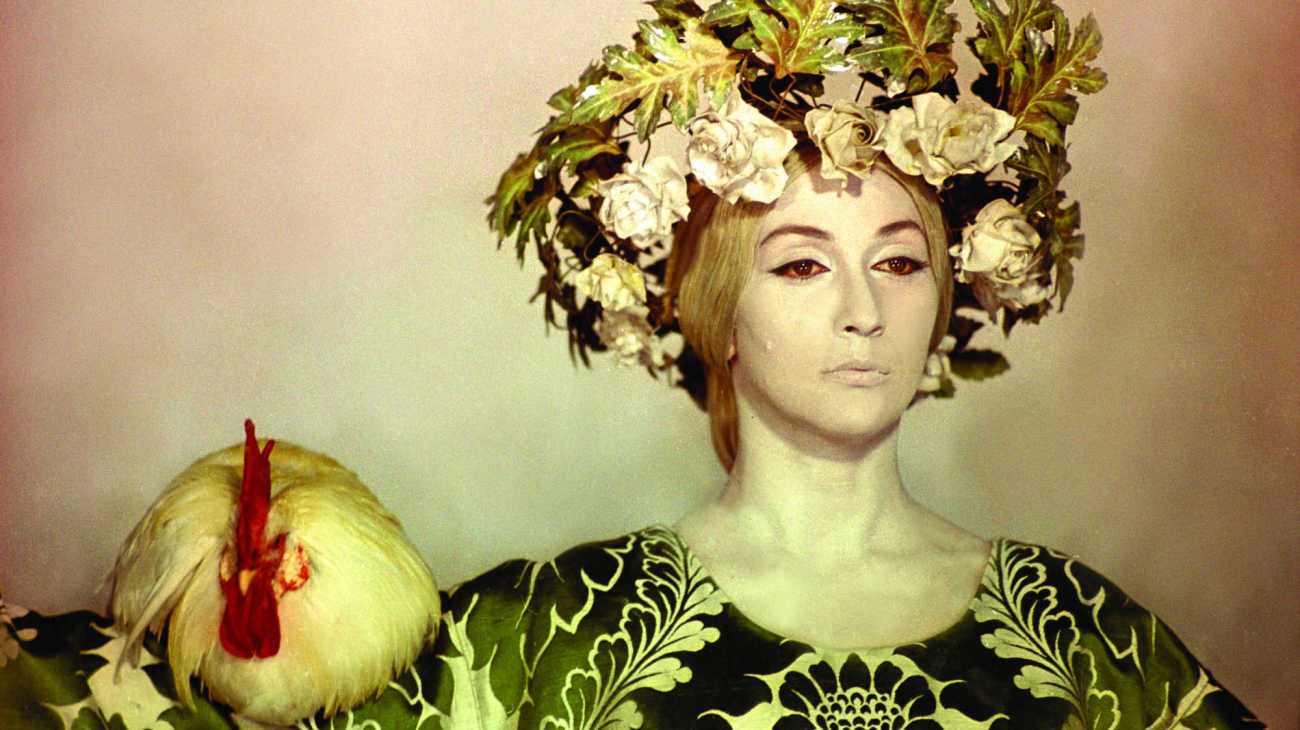
They Shoot Pictures, Don't They? 2008 Edition - #388
It's an embarrassing thing to say about one of the highest-regarded Soviet art films ever produced, but try though I might, as I watched Sergei Parajanov's Color of Pomegranates, I could never quite shake the ghost of Monty Python's parodies of inscrutable art films. You know what I'm talking about, if you've seen enough Flying Circus episodes: stern-faced people standing outdoors, not moving, and then the film stops and Terry Jones appears in the upper corner wearing a hobo costume, that sort of thing. Or, the Middle of the Film sketch in The Meaning of Life. The point being, if you have in your head an idea of "pretentious European art film from the 1960s," I can virtually guarantee that The Color of Pomegranates looks pretty much exactly like what you're thinking of.
And yet...oh, there's always an "and yet" with me. Though it may well be artsy to the point of absurdity, it's not quite "pretentious", I don't think. Of course, pretension is in the eye of the beholder, but I like to reserve the word for anything which seems positively smug about how hard it is to understand, and how terrifically clever the director had to be to make it, and just be a giant exercise in back-patting all around: we who made/like this film are SO MUCH BETTER than normal people. I just don't get that feeling from Parajanov's film, though I guess some people might disagree with me. Partially, I think it's because any filmmaker out to prove how damn smart he was in the Soviet Union probably didn't have much of a survival instinct, and partially it's because The Color of Pomegranates really isn't that hard - in fact, one of its defining characteristics is how tremendously easy it is to understand, for a film that does so much to violate all the normal rules of cinema.
In the loosest possible sense, the film is about the life of the 18th Century Armenian poet Sayat-Nova (the original Russian title was actually Sayat Nova, before the government came in, chopped a few minutes from the film, and renamed it Red Pomegranate). But as Parajanov warns us right in the first seconds of the movie, by means of an intertitle, this is no narrative biography; it is an attempt to convey by cinematic means the events in Sayat-Nova's life and the emotions surrounding those events. At the same time, The Color of Pomegranates is an attempt to express in film the meaning of the poet's writing.
This is exactly why I can't regard it as "pretentious". It didn't take an army of mirthless scholars to conclude that the film is an attempt to replicate poetry using visuals and sound; Parajanov tells us so, right at the start. And with that knowledge in mind, the apparent indulgences withing the film aren't indulgent at all - it's an extremely honest attempt to convey abstraction in an essentially non-abstract medium. By and large, it is successful in this attempt, though not in any way that is especially easy to describe rationally (which is, by all accounts, just how Parajanov wanted it). Here's my attempt to do so, anyway: I think the film's use of sound has a lot to do with its curious effect. Most of what we hear in the film was not apparently recorded along with the images, and it's certain that the extremely tiny amount of speech wasn't, except in one instance. So when you're watching water running down rock faces, or wind blowing the pages of books, et cetera, the sound of water and the sound of wind doesn't exactly match the image. It's close, but something is "off" with it; and that "offness" is the movie's poetry. You see the pages blowing, and it means something to you; you hear the pages blowing, and it means something else; and then the two of those things happen together, and the combination is what causes you to think about the Platonic "Wind Blowing Through Pages" that is the poetic, rather than the recorded image. I have literally no idea what this paragraph was supposed to mean.
That's the problem with trying to explain a work of art which is meant to be inexlicable; if you succeed, all you've really done is broken the movie. Which would be a tremendous sin against The Color of Pomegranates, which is really doing exactly what it says, putting us in the mind of a poet at all stages of his development. But how do you describe that? We don't think in complete sentences, after all, but in fragments, images, concepts. Certain shots in the film are tremendously beautiful in a purely abstract sense (the aforementioned wind/pages shot), some are interesting for what they show (a detailed, step-by-step document of how yarn is died), some simply put a human face up close to the lens and dare us to read something into the deliberately inscrutable, emotionless features on display. There isn't meant to be an "answer" to the film, because it doesn't raise any questions; its goal is to cause an emotional response in the viewer and this it does directly, rather than by creating a scenario for us to respond to. In this it may be one of the most purely cinematic works I have ever seen. But other than lamely suggesting that you go see it yourself, I can't really do much here on a blog.
After The Color of Pomegranates, which was banned, the homosexual Parajanov was imprisoned for ten years for deviance, and for creating art that ran contrary to the dictates of social realism (he would complete only two more features before his death in 1990, both of them only marginally more representational). That the Soviet government wouldn't know what to do with a film like this isn't really surprising at all; it exists without reference to anything outside of itself, and the effect it tries to have on the viewer. It has a solipsistic purity that's easy to condemn and easy to praise, but either way its uniqueness guarantees it a position in the pantheon of great art movies.
And yet...oh, there's always an "and yet" with me. Though it may well be artsy to the point of absurdity, it's not quite "pretentious", I don't think. Of course, pretension is in the eye of the beholder, but I like to reserve the word for anything which seems positively smug about how hard it is to understand, and how terrifically clever the director had to be to make it, and just be a giant exercise in back-patting all around: we who made/like this film are SO MUCH BETTER than normal people. I just don't get that feeling from Parajanov's film, though I guess some people might disagree with me. Partially, I think it's because any filmmaker out to prove how damn smart he was in the Soviet Union probably didn't have much of a survival instinct, and partially it's because The Color of Pomegranates really isn't that hard - in fact, one of its defining characteristics is how tremendously easy it is to understand, for a film that does so much to violate all the normal rules of cinema.
In the loosest possible sense, the film is about the life of the 18th Century Armenian poet Sayat-Nova (the original Russian title was actually Sayat Nova, before the government came in, chopped a few minutes from the film, and renamed it Red Pomegranate). But as Parajanov warns us right in the first seconds of the movie, by means of an intertitle, this is no narrative biography; it is an attempt to convey by cinematic means the events in Sayat-Nova's life and the emotions surrounding those events. At the same time, The Color of Pomegranates is an attempt to express in film the meaning of the poet's writing.
This is exactly why I can't regard it as "pretentious". It didn't take an army of mirthless scholars to conclude that the film is an attempt to replicate poetry using visuals and sound; Parajanov tells us so, right at the start. And with that knowledge in mind, the apparent indulgences withing the film aren't indulgent at all - it's an extremely honest attempt to convey abstraction in an essentially non-abstract medium. By and large, it is successful in this attempt, though not in any way that is especially easy to describe rationally (which is, by all accounts, just how Parajanov wanted it). Here's my attempt to do so, anyway: I think the film's use of sound has a lot to do with its curious effect. Most of what we hear in the film was not apparently recorded along with the images, and it's certain that the extremely tiny amount of speech wasn't, except in one instance. So when you're watching water running down rock faces, or wind blowing the pages of books, et cetera, the sound of water and the sound of wind doesn't exactly match the image. It's close, but something is "off" with it; and that "offness" is the movie's poetry. You see the pages blowing, and it means something to you; you hear the pages blowing, and it means something else; and then the two of those things happen together, and the combination is what causes you to think about the Platonic "Wind Blowing Through Pages" that is the poetic, rather than the recorded image. I have literally no idea what this paragraph was supposed to mean.
That's the problem with trying to explain a work of art which is meant to be inexlicable; if you succeed, all you've really done is broken the movie. Which would be a tremendous sin against The Color of Pomegranates, which is really doing exactly what it says, putting us in the mind of a poet at all stages of his development. But how do you describe that? We don't think in complete sentences, after all, but in fragments, images, concepts. Certain shots in the film are tremendously beautiful in a purely abstract sense (the aforementioned wind/pages shot), some are interesting for what they show (a detailed, step-by-step document of how yarn is died), some simply put a human face up close to the lens and dare us to read something into the deliberately inscrutable, emotionless features on display. There isn't meant to be an "answer" to the film, because it doesn't raise any questions; its goal is to cause an emotional response in the viewer and this it does directly, rather than by creating a scenario for us to respond to. In this it may be one of the most purely cinematic works I have ever seen. But other than lamely suggesting that you go see it yourself, I can't really do much here on a blog.
After The Color of Pomegranates, which was banned, the homosexual Parajanov was imprisoned for ten years for deviance, and for creating art that ran contrary to the dictates of social realism (he would complete only two more features before his death in 1990, both of them only marginally more representational). That the Soviet government wouldn't know what to do with a film like this isn't really surprising at all; it exists without reference to anything outside of itself, and the effect it tries to have on the viewer. It has a solipsistic purity that's easy to condemn and easy to praise, but either way its uniqueness guarantees it a position in the pantheon of great art movies.






